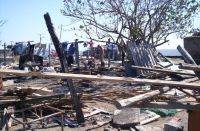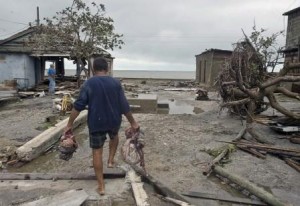Enough’s Enough for Coastal Dwellers
By DALIA ACOSTA

HAVANA TIMES, Dec 3 (IPS).- She was born, grew up and lived all her life just a few steps from the sea, in the part of the city that everyone knows simply as La Playa (the beach). Although she was lucky enough to return to a home and belongings that withstood Hurricane Paloma’s mighty waves, Iramis Rodriguez has made up her mind to move inland.
“If they’ll take me, I’ll go,” the 30-year-old Santa Cruz del Sur, Camaguey resident told IPS. Rodriguez is part of the janitorial staff in a government facility located “right here in Santa Cruz,” she says.
The meter high storm surge left its mark on the walls of her house. The roof took some damage and the mattresses and appliances got wet, but nothing that the sun cannot fix. “Now, we need to help those who are in worse shape, while we wait for a permanent solution,” says Rodriguez’s husband, Ramón del Campo.
The monument in memory of the victims of the Nov. 9, 1932 hurricane -the worst natural disaster in the history of Cuba- is visible from her door. Closer to the coast stands a cross marking the height reached by the storm surge that tragic day: some six meters, according to the few survivors.
Some 3,000 people were killed that day in 1932, “stabbed” by all sorts of objects that were hurled through the air by the powerful winds, trapped inside their homes, swallowed up by the sea as it pulled back, or scorched among the debris burnt by order of the authorities who wanted to prevent an epidemic at all costs.
This time, when the families returned on Nov. 11 to this town located some 600 kilometers east of Havana, the landscape they found was both similar and different to the one left 76 years ago. Dogs with glazed eyes roamed streets that had turned alien; here and there an animal was trapped under boards. But the community had survived.
The first line of houses, along the sea, had disappeared almost completely. In some places, nothing was left, only part of the foundations, as a reminder that there had once been a home there. Not even the sturdiest dwellings, which had been chosen by the neighbors as a safe place to store their refrigerators, were left standing.
“This is like the 1932 hurricane without the death toll,” Alicia Reitor, 58, remarked to IPS. Reitor was part of the first Catholic Church brigades that came to the coastal area to bring “some material aid, but most of all to lend spiritual support to these people who have lost everything,” she said.

More than 20,000 people were evacuated from Santa Cruz del Sur, a municipality of 49,900 people, as Hurricane Paloma — the third major hurricane to hit Cuba this year — approached. While in 1932, the entire town was left waiting for an evacuation train that never arrived, this time not a single person stayed back in the poor district of La Playa.
When Paloma struck, it damaged 9,022 homes: 1,155 were totally destroyed, 1,422 partially wrecked, and 1,227 lost their roofs. Of the 480 houses in La Playa, about half were completely razed, and the ones that were left standing all suffered damages to some degree.
WEATHERING THE STORM
Fernando Zamora, 51, had decided with his family that he would go back to their house to make sure that their most important possessions were secured. He planned to take a few things to a safer place: the refrigerator, the television set, and maybe their new living room furniture, for which they had made so many sacrifices to buy.
A worker at a shrimp farming company, Zamora spent the hours prior to the arrival of Hurricane Paloma helping in the evacuation, as he is a member of the Municipal Defense Council. “As it turned out, I couldn’t make it in time to get our things, but I was sure the house would survive,” he told IPS.
When they came back three days later, the only things the family could salvage from the wreckage were a few pots, some clothes and the odd photograph. Zamora, like Ramón del Campo and so many other men, felt that they had to try to salvage the unsalvageable, putting up makeshift walls and roofs to live through the aftermath.
The women recovered clothes from the mud and the water’s edge, set up collective kitchens to cook meals with the free food distributed by the government and some local ingredients, took care of the pets and small livestock and tried as much as possible to keep the children from feeling the effects of the disaster.
“Men and women deal with this situation differently. The women turn to the doctors to talk, they express what they’re feeling. The men stay back; it’s like they don’t want to show that this is affecting them emotionally. This way of coping could be worse,” psychiatrist Daysi Roque told IPS.
Roque was part of a group of 20 specialists, including psychiatrists, psychologists, occupational therapists, and nurses that traveled to Santa Cruz del Sur four days after Hurricane Paloma hit to conduct an emergency assessment, with the aim of detecting any cases of people affected by trauma or severely distressed.
“There are different ways of helping people deal with what they’re going through: counseling, talking, listening, and, especially, letting them know that we’re always going to be there for them,” Yoandro Ávalo said to IPS. Ávalo was part of the Cuban Red Cross team that traveled to Santa Cruz del Sur to help with the evacuation and the post-disaster recovery efforts.
Cuba has suffered an estimated 10 billion dollars in losses from the damages caused by hurricanes Gustav, Ike and Paloma, when they stormed through the island on Aug. 30, Sept. 8-9, and Nov. 9, respectively. But statistics say nothing of all the memories the hurricanes took with them: family photographs, children’s toys, books painstakingly collected by a local teacher throughout her life.
FAREWELL TO THE SEA
“If you were given the chance to leave this place, would you go?” IPS asked more than 15 La Playa residents. The answer, in a sad but firm tone, was invariably yes.
That seems to be the only solution possible for communities like Santa Cruz del Sur, Cajío, Guanimar, or so many others, which year after year live under the threat posed by the sea. In 2002, an official report calculated that there were 244 neighborhoods, villages or towns, home to 1.4 million people, that were vulnerable to coastal floods.
“These are areas located one meter below the mean sea level and at a distance of less than one thousand meters from the coastline,” according to the report presented by Cuba at a regional meeting on “Local Management and Risk Reduction within Human Settlements in the Caribbean Basin.”
With the increase in cyclone intensity and sea-level rise projections, the Cuban government has recognized that the only solution for these communities is to relocate further inland. The decision is already being implemented in Santa Cruz del Sur, with the construction of temporary housing for those left homeless by the hurricane.
The site, three kilometers from La Playa, is already being conditioned to build several apartment buildings, for the relocation of local residents.
“We grew up hearing stories of the 1932 hurricane, but we never thought that something like that could ever happen again. We had never lived in fear of the sea, but now things have changed. We have to go because what happened here could happen again,” the twice-Olympic medalist in canoeing Ibrahím Rojas told IPS.
Rojas no longer lives in Santa Cruz del Sur, but he came back to his childhood home to help his mother rebuild her house. “This was supposed to be the place where she was going to spend her old age, and now she can’t wait to move,” he said “When we saw what had happened … it was the most painful thing we ever felt.”
